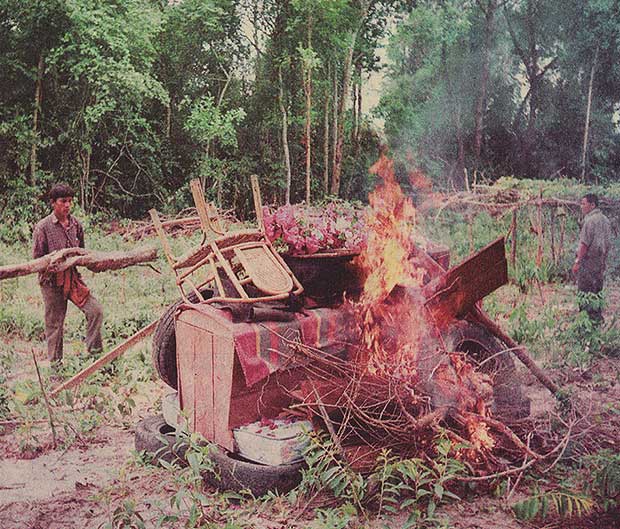At Cremation Of Pol Pot, No Tears Shed
CHONG SA-NGAM, Thailand, April 18, 1998 : First a thin white plume rose into the gray sky above the forest here on the Thai-Cambodian border. Then a cascade of black, acrid smoke. At precisely 9:52 this morning, a young Khmer Rouge guerrilla touched a red plastic cigarette lighter to a stack of kindling, and soon the body of Pol Pot, one of the century’s great mass killers, was consumed on a makeshift pyre of burning tires and debris.
There were no words of eulogy and no tears as the flames crackled and grew in a clearing just inside Cambodia.
As the tires and the kindling burned away, Pol Pot’s blackened skeleton remained within the orange flames, its right arm and fist raised upward.
Only a dozen people witnessed the cremation of the man who drove Cambodia to ruin, causing the deaths of two million people when he ruled the country from 1975 to 1979. All but one wandered off before the fire had burned down.

The witnesses included several low-ranking guerrillas from the Communist movement Pol Pot had led for three decades, and a small group of photographers who were invited to record the moment on cameras and videotape. Other journalists were halted at a checkpoint here on the Thai side of the border, where they watched the smoke rise 500 yards away. The Thai military later made a videotape available.
Pol Pot’s widow and their 14-year-old daughter did not attend, nor did the remaining Khmer Rouge leaders, who are under heavy military pressure from Cambodian Government troops.
There was no pause in the fighting to honor the moment. Artillery and mortar fire could be heard sporadically throughout the morning.
Pol Pot’s death late Wednesday night at 73 was a signal of the demise of the Khmer Rouge insurgency, which has hidden in Cambodia’s mountains and jungles for 19 years. A small core of hard-line leaders remains, along with several hundred fighters, and they could hold out for months to come. But the end is only a matter of time.
Cambodia’s pain and its bitter politics — legacies of Pol Pot’s destructive rule — are being played out now in the distant capital of Phnom Penh, where a violent campaign is under way for elections in July.
Pol Pot had already become a non-person. After a violent rupture in the leadership last June, he became a prisoner of his former lieutenants, and at a show trial in July, he was sentenced to life under house arrest.
Even as they faced the end game of their insurgency, the Khmer Rouge holdouts seemed to hope that the death of Pol Pot could cleanse their image and allow them to seek an amnesty.
”Most people are happy because Pol Pot is finished now,” said Noun Nou, a Khmer Rouge official who spoke to reporters at the border. ”There is no more Khmer Rouge, no more bad reputation.”
But the United States, which had hoped to put Pol Pot on trial, has announced that it will now seek the capture and trial of some of the remaining leaders.
Pol Pot’s widow, Mea Son, said Friday that he had died quietly in his bed after eating a dinner of rice. Khmer Rouge officials said the cause of death was a heart attack. But no autopsy was performed and suspicions remain that he might have been killed by his associates to prevent his capture and a trial that could have implicated them.
Today’s events began in Pol Pot’s shack, where several guerrillas used a hatchet to hammer together a crude wooden coffin.
Then they lifted Pol Pot’s remains from his narrow bed and tossed his straw fan, his scarf, his belt and a small black knapsack of his clothes into the coffin with him. Six soldiers hefted the coffin onto the pyre.
Eight tires formed the base of the pyre. On top of them was the mattress from Pol Pot’s bed. His wicker chair was laid upside down on top of his coffin along with more tires.
Three soldiers added sprays of white and pink fuchsia to the pyre, the day’s one touch of sentiment.
Mr. Noun Nou said Pol Pot’s bones would be given to his wife and daughter, a Cambodian tradition.
His ashes are to be taken by couriers to be scattered in three places.
One is Cambodia’s great lake, Tonle Sap, the heart of the nation’s history and culture, near the ancient temple complex of Angkor Wat and not far from Kompong Thom, where he was born. The second is the country’s eastern region, where Pol Pot began his jungle revolution in the 1960’s. The third is here in the Dangrek Mountains, where both his life and his revolution have come to an end.
Copyright The New York Times